Daily Current Affairs for UPSC 24th Oct 2025



| Index |
| S.No | Topic | Page No |
| Daily Hindu Analysis (YouTube) |
| 1. | The UN matters, as a symbol of possibility |
|
| 2. | Should India take global leadership on climate change? |
|
| 3. | U.S. sanctions Russian oil; Indian refineries poised to cut imports |
|
| 4. | Tri-services to get systems, platforms for ₹79,000 cr. |
|
| 5. | 90% of Gaganyaan development work done: ISRO chief |
|
| 6. | India, Bhutan review security cooperation, border management |
|
| 7. | Why cloud seeding is not a solution to Delhi’s air pollution crisis |
|
| Daily Current Affairs |
| 8. | ‘23for23’ Initiative |
|
| 9. | United Nations (UN) |
|
| 10. | ASEAN |
|
| 11. | International Convention against Doping in Sport |
|
The UN matters, as a symbol of possibility
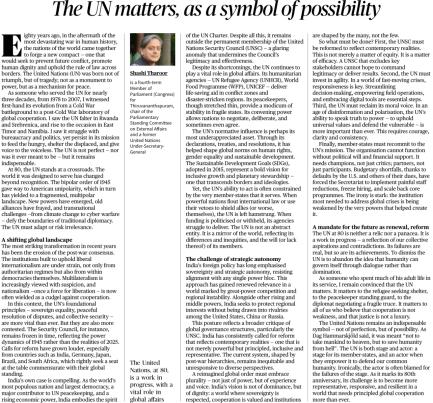
GS Paper: GS-2 – International Relations (Important International Institutions, UN and its Role)
Context · As the United Nations (UN) marks its 80th anniversary, debates about its relevance have intensified amid a shifting global order. · Despite criticism over inefficiency and outdated structures, the UN continues to serve as a symbol of multilateral cooperation, peace, and human dignity· The article by Shashi Tharoor highlights how, even with flaws, the UN remains indispensable in addressing global crises and upholding collective action.
Background: Evolution of the UN
- Founded in 1945 in the aftermath of World War II, the UN aimed to prevent future wars, uphold human rights, and promote peace and development.
- It evolved from a Cold War battleground to a post-Cold War platform for global cooperation.
- Over time, it has played key roles in peacekeeping (Rwanda, East Timor, Srebrenica), humanitarian assistance, decolonisation, and sustainable development.
A Changing Global Landscape - The bipolar order of 1945 has transformed into a multipolar world with new power centres (India, China, Brazil).
- Multilateralism faces growing pressure from nationalism and protectionism.
- Challenges such as climate change, cyberwarfare, pandemics, and inequality transcend borders, demanding renewed global cooperation.
- Yet, the UN’s institutional mechanisms, especially the UN Security Council (UNSC), remain largely frozen in the 1945 power structure.
Current Challenges Before the UN 1. Outdated Power Structure: o The UNSC’s five permanent members (P5)—U.S., U.K., France, Russia, China—reflect 1945 realities, not 2025 geopolitics. o Emerging powers like India, Japan, Germany, Brazil lack permanent membership.
2. Veto Power Paralysis: o Powerful nations often block global consensus on issues such as Syria, Ukraine, and Gaza.
3. Erosion of Multilateralism: o Rise of regionalism and unilateralism weakens the global order.
4. Resource and Funding Constraints: o Dependence on major powers affects operational independence.
UN’s Continued Relevance
- Despite its flaws, the UN remains the only truly global institution representing 193 member states.
- Humanitarian agencies (UNHCR, WFP, UNICEF) continue to deliver critical aid and promote stability.
- The UN’s normative influence through the Universal Declaration of Human Rights and Sustainable Development Goals (SDGs) remains unmatched.
- It provides a moral and deliberative platform for small and developing nations to voice concerns.
Way Forward – Making the UN Fit for Purpose 1. UNSC Reform: o Expand permanent membership to include India, Brazil, Germany, Japan, and African representation. o Rationalise the veto system to ensure accountability.
2. Revitalise Decision-Making: o Empower the UN General Assembly to play a larger role in global governance.
3. Enhance Agility: o Modernise peacekeeping operations and adopt rapid response mechanisms.
4. Moral Renewal: o Reaffirm the UN’s founding principles — dignity, equality, and global solidarity — to restore faith in multilateralism.
UPSC Mains
Q. “The United Nations, despite its structural limitations, remains indispensable in upholding global peace and cooperation.” Discuss in light of contemporary global challenges.
Should India take global leadership on climate change?
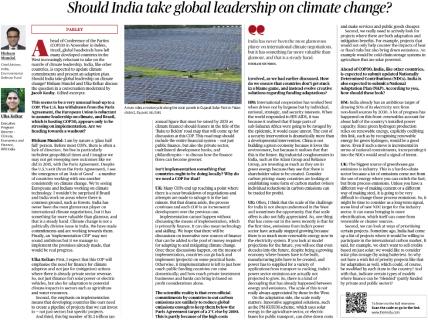
GS Paper: GS-3 – Environment, Conservation, Climate Change Context · Ahead of COP30 (Conference of the Parties) to be held in Belém, Brazil, in November, global climate negotiations face a crisis of leadership. · With the U.S. withdrawing from the Paris Agreement, and the EU focusing on internal implementation, the world is looking to major emerging economies — particularly India — to step up as a credible, steady leader on climate action.
Background: The Global Context
- Geopolitical shifts: Developed nations are scaling back their commitments amid economic strain, energy crises, and political polarisation.
- Brazil (COP host) has prioritised implementation over new pledges, leaving a leadership vacuum.
- India’s position: Despite being the third-largest emitter, India has also emerged as one of the most consistent performers in renewable energy expansion and emission intensity reduction.
India’s Climate Commitments 1. Nationally Determined Contributions (NDCs) – India aims to: o Reduce emission intensity of GDP by 45% from 2005 levels by 2030. o Achieve 50% cumulative electric power capacity from non-fossil fuel sources by 2030. o Achieve net-zero emissions by 2070.
2. National Adaptation Plan (NAP) – Focused on agriculture, water, coastal protection, and infrastructure resilience.
3. Key domestic initiatives: o National Solar Mission, Green Hydrogen Mission, National Bioenergy Programme. o International Solar Alliance (ISA) and Coalition for Disaster Resilient Infrastructure (CDRI) demonstrate India’s global engagement.
India’s Strengths in Climate Leadership
- Moral credibility: India has historically contributed <4% of cumulative global emissions, yet is among the few countries on track to meet its Paris targets.
- Policy framework: Clear roadmap for renewables, energy efficiency (Perform-Achieve-Trade scheme), and carbon markets.
- South-South cooperation: Leadership in forums like ISA reflects India’s inclusive, technology-sharing approach.
- Balanced diplomacy: Advocates for climate justice and common but differentiated responsibilities (CBDR) — key to bridging North–South divides.
Challenges to Taking Global Leadership 1. Domestic priorities: India must ensure energy access, industrialisation, and poverty alleviation while decarbonising.
2. Financial constraints: Estimated need of $10 trillion for energy transition by 2070; climate finance commitments from developed nations remain unmet.
3. Technological dependence: Limited access to affordable green technologies and intellectual property rights barriers.
4. Global uncertainty: Rising protectionism, carbon border adjustment mechanisms, and geopolitics complicate cooperative action.
Way Forward: Leadership through Pragmatism
- “Steady hand” approach: Rather than seeking glamour or confrontation, India can provide stable, credible leadership by:
- Promoting renewable energy finance and low-carbon industrial models.
- Strengthening climate adaptation projects, e.g., solar-powered cold storage systems for agriculture.
- Advocating inclusive climate finance reforms at global forums (IMF, World Bank).
- Collaborative diplomacy: Align with Brazil and African nations to lead the Global South bloc at COP30.
- Domestic transformation: Implement green jobs, clean transport, and sustainable cities to set an example for emerging economies.
UPSC Mains Q.
“In an era of retreating Western climate leadership, India’s pragmatic and inclusive approach offers a new model of global environmental governance.” Discuss India’s potential role in leading global climate action while addressing its developmental priorities.
U.S. sanctions Russian oil; Indian refineries poised to cut imports
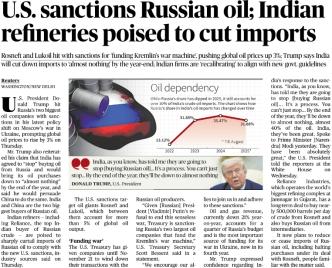
Syllabus Mapping · GS Paper 2: International Relations — India and its Relations with Major Powers ·
GS Paper 3: Economy — Energy Security, Effects of Globalization on Indian Economy
Context · The United States has imposed fresh sanctions on Russia’s two largest oil companies — Rosneft and Lukoil — accusing them of funding the Kremlin’s war machine amid the ongoing war in Ukraine. · As a result, India’s oil refiners, among the biggest buyers of discounted Russian crude, are expected to reduce imports sharply to align with new U.S. guidelines.
Background
- Since the Russia–Ukraine conflict (2022), Russia emerged as India’s largest crude oil supplier, accounting for over 30–35% of total imports.
- India took advantage of discounted crude while maintaining a balanced diplomatic stance — neither joining Western sanctions nor endorsing Russian aggression.
- The latest U.S. move marks a renewed effort to tighten sanctions and curb Russia’s oil revenues that fund the war.
Key Developments 1. New U.S. Sanctions: o Target Rosneft and Lukoil, prohibiting global firms from trading with or financing these companies. o Sanctions effective till November 21, with the goal of cutting Russia’s export avenues.
2. Impact on India: o Indian refiners such as Reliance Industries (Jamnagar refinery) and Indian Oil Corporation may scale down Russian crude imports. o India’s imports from Russia are expected to fall from ~40% of total crude to “almost nothing” by year-end 2025, per U.S. statements.
3. Global Oil Prices: o The sanctions have already caused a 3% rise in global oil prices. o This could affect inflation and current account balances for energy-importing countries like India.
4. India’s Energy Security Strategy: o India is diversifying crude sources — increasing imports from the Middle East, U.S., and Latin America. o Reliance on Russian oil has been tactical — based on economic benefit, not political alignment. Significance
- Highlights India’s balancing diplomacy — maintaining strategic autonomy between major powers (U.S. and Russia).
- Underscores the fragility of global energy markets under geopolitical stress.
- Raises questions about energy transition and supply security amid growing volatility.
UPSC Prelims Q. With reference to India’s crude oil imports, consider the following statements: 1. Russia is India’s largest supplier of crude oil as of 2025. 2. Rosneft and Lukoil are major Russian companies recently targeted by U.S. sanctions. 3. India’s crude imports from Russia account for over one-third of its total oil imports. Which of the statements given above are correct?
(a) 1 and 2 only
(b) 2 and 3 only
(c) 1 and 3 only
(d) 1, 2 and 3
Answer: (b) 2 and 3 only
Tri-services to get systems, platforms for ₹79,000 cr.
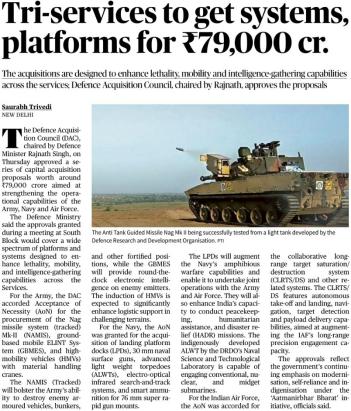
GS Paper: GS-3 – Defence & Security / Science & Technology (Indigenisation of Technology)
Context The Defence Acquisition Council (DAC), chaired by Defence Minister Rajnath Singh, has approved capital acquisition proposals worth ₹79,000 crore.
These acquisitions aim to enhance lethality, mobility, surveillance, and intelligence-gathering capabilities across the Army, Navy, and Air Force — reinforcing India’s focus on self-reliance under the “Aatmanirbhar Bharat” initiative.
What is the Defence Acquisition Council (DAC)? - The apex body of the Ministry of Defence (MoD) for approving capital procurements for the Armed Forces.
- Chaired by the Defence Minister.
- It grants the Acceptance of Necessity (AoN) — the first step before procurement begins.
Key Highlights of the Current Approvals 1. Indian Army - Approval for procurement of:
- Nag Mk-II (NAMIS) – a tracked anti-tank guided missile system to destroy enemy armour.
- GBMES – Ground-Based Mobile ELINT System for electronic intelligence collection.
- High Mobility Vehicles (HMVs) – for logistics and transport in difficult terrains.
2. Indian Navy - Acquisition of:
- Landing Platform Docks (LPDs) – to enhance amphibious warfare and disaster-relief capabilities.
- 30 mm naval guns, lightweight torpedoes (ALWTs), and infrared search-and-track systems.
- Smart ammunition for superior precision.
3. Indian Air Force - Induction of:
- Collaborative Long-Range Target Saturation/Destruction System (CLRTS/DS) – autonomous take-off, navigation, and payload delivery for precision strike capability.
- Designed to strengthen India’s long-range precision engagement and surveillance capacity.
Significance - Strengthens operational readiness and jointness among the three services.
- Boosts indigenisation and defence manufacturing ecosystem under Make in India.
- Enhances India’s ability to undertake peacekeeping, humanitarian assistance, and disaster-relief missions globally.
- Reflects India’s transition from being an arms importer to a systems developer.
UPSC Prelims Q. With reference to the Defence Acquisition Council (DAC), consider the following statements: 1. It is the highest decision-making body in the Ministry of Defence for capital acquisitions. 2. The DAC is chaired by the Defence Secretary. 3. It grants the Acceptance of Necessity (AoN) for procurement proposals. Which of the statements given above are correct?
(a) 1 and 3 only
(b) 2 and 3 only
(c) 1 only
(d) 1, 2 and 3
Answer: (a) 1 and 3 only
90% of Gaganyaan development work done: ISRO chief
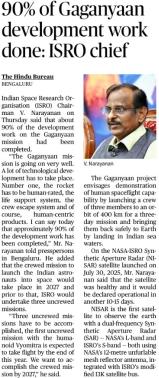
Syllabus Mapping:
GS Paper 3 – Science and Technology: “Achievements of Indians in science & technology; indigenisation of technology and development of new technology; space technology and its applications.”
Context · The Indian Space Research Organisation (ISRO) has completed around 90% of the development work for the Gaganyaan Mission, India’s first human spaceflight programme. · ISRO Chairman V. Narayanan announced that the mission is progressing well, with major systems such as the human-rated rocket, life support, and crew escape system nearing completion.
About Gaganyaan Mission - Objective: To demonstrate India’s human spaceflight capability by launching a crew of three astronauts into Low Earth Orbit (LEO) of about 400 km for a 3-day mission, followed by safe re-entry and recovery in Indian sea waters.
- Launch Year: Planned for 2027 (after completing three uncrewed test missions).
- Crewed Vehicle: Will be launched using the human-rated LVM3 rocket (HLVM3).
- Key Components:
- Crew Module (CM): Provides living and working space for astronauts.
- Service Module (SM): Houses propulsion and support systems.
- Crew Escape System (CES): Ensures astronaut safety during launch emergencies.
- Uncrewed Missions: Three test flights, including one with the Vyommitra humanoid, will precede the human mission to validate safety systems.
Parallel Development - ISRO is also working on the NASA–ISRO Synthetic Aperture Radar (NISAR) mission — the first dual-frequency Earth observation satellite using L-band (NASA) and S-band (ISRO) radars, scheduled for launch in July 2025.
Significance - Positions India among elite nations (U.S., Russia, China) with independent human spaceflight capability.
- Boosts indigenous space technology, aerospace manufacturing, and defence preparedness.
- Strengthens India’s credentials for future projects like the Bharatiya Antariksha Station and potential Moon/Mars missions.
- Encourages youth innovation and advances India’s Atmanirbhar Bharat vision in space research.
UPSC Prelims Q. With reference to India’s Gaganyaan Mission, consider the following statements: 1. It aims to place three astronauts in a low Earth orbit of about 400 km for three days. 2. The crew module will be launched using the human-rated LVM3 rocket. 3. The mission includes multiple uncrewed test flights before the final human mission. Which of the statements given above are correct?
(a) 1 and 2 only
(b) 2 and 3 only
(c) 1, 2 and 3
(d) 1 only
Answer: (c) 1, 2 and 3
India, Bhutan review security cooperation, border management 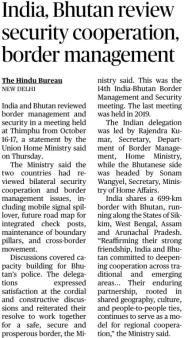
Syllabus Mapping:
GS Paper 2 – International Relations:
GS Paper 2 – International Relations: GS Paper 2 – International Relations: - India and its neighbourhood – relations.
- Bilateral, regional, and global groupings involving India and/or affecting India’s interests.
Context · India and Bhutan recently held the 14th India–Bhutan Border Management and Security Meeting at Thimphu (October 16–17, 2025) after a gap of several years (last held in 2019). · The meeting reviewed ongoing bilateral security cooperation, border management, and capacity-building efforts, reaffirming the enduring strategic partnership between the two neighbours.
- Key Issues Discussed:
- Managing mobile signal spillover along the border.
- Developing a road map for integrated check-posts.
- Maintenance of boundary pillars and facilitation of cross-border movement.
- Capacity building and training support for Bhutanese police forces.
India–Bhutan Border Facts - Length: 699 km
- States sharing border with Bhutan:
- Sikkim, West Bengal, Assam, Arunachal Pradesh
- Nature of Border: Peaceful and well-managed — symbol of strong trust and cooperation.
Significance - Strengthens bilateral coordination on security amid emerging challenges in the Himalayas.
- Reinforces India’s Neighbourhood First Policy and Act East Policy.
- Supports Bhutan’s capacity building, enhancing institutional cooperation in law enforcement and border management.
- Promotes people-to-people ties and regional stability, vital in the context of evolving geopolitical dynamics with China.
UPSC Prelims Q. Consider the following statements regarding the India–Bhutan border: 1. India shares its border with Bhutan through the states of Sikkim, West Bengal, Assam, and Arunachal Pradesh. 2. The India–Bhutan border is 699 km long. 3. The 14th India–Bhutan Border Management and Security Meeting was held in New Delhi in 2025. Which of the statements given above are correct?
(a) 1 and 2 only
(b) 2 and 3 only
(c) 1 only
(d) 1, 2 and 3
Answer: (a) 1 and 2 only
Why cloud seeding is not a solution to Delhi’s air pollution crisis
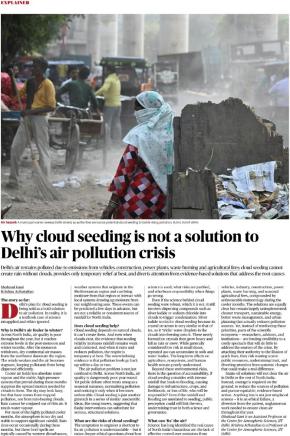
Syllabus Mapping:
GS Paper 3 – Environment:
GS Paper 3 – Environment: GS Paper 3 – Environment: - Conservation, environmental pollution and degradation, environmental impact assessment.
- Science and technology applications in environmental management.
Context · With Delhi’s air quality plummeting every winter, authorities have proposed cloud seeding to induce artificial rain as a quick-fix measure. · However, experts argue that this is scientifically unreliable, provides only temporary relief, and diverts attention from systemic solutions to address the root causes of pollution.
What is Cloud Seeding?
- A weather modification technique where chemicals like silver iodide or sodium chloride are dispersed into clouds to stimulate rainfall.
- It requires existing clouds with sufficient moisture — it cannot create clouds or guarantee rain.
Why Delhi’s Air Pollution Peaks in Winter - Meteorological factors: Cold temperatures, low wind speed, and temperature inversion trap pollutants near the surface.
- Source-based factors:
- Vehicular and industrial emissions
- Construction dust
- Waste and stubble burning
- Coal-based power plants
- These combine to form toxic smog, worsening air quality during post-monsoon and winter months.
Why Cloud Seeding is Ineffective 1. Depends on existing clouds — not feasible in Delhi’s dry winter skies. 2. Short-term relief — even if rainfall occurs, it only temporarily washes pollutants from the air. 3. Scientific uncertainty — effectiveness remains inconsistent and unproven. 4. Environmental risks — silver iodide can accumulate in soil and water bodies, affecting ecosystems. 5. Ethical and governance issues — lack of clear accountability if the process fails or causes unintended harm.
Real Solution Lies In - Long-term structural measures, including:
- Transition to cleaner transport and renewable energy.
- Sustainable construction practices.
- Urban planning to reduce congestion and emissions.
- Agricultural reforms to curb stubble burning.
- Public awareness and behavioral change.
UPSC Prelims Q. With reference to cloud seeding, consider the following statements: 1. Cloud seeding can generate new clouds and cause rainfall even in clear skies. 2. Silver iodide and sodium chloride are commonly used substances in the process. 3. The success of cloud seeding depends on the availability of sufficient cloud moisture. Which of the statements given above are correct?
(a) 1 and 2 only
(b) 2 and 3 only
(c) 1 and 3 only
(d) 1, 2 and 3
Answer: (b) 2 and 3 only
‘23for23’ Initiative
Syllabus:
GS Paper III – Environment, Ecology & Biodiversity
Topic: Conservation of Endangered Species & Government Initiatives
Context:
India celebrated
International Snow Leopard Day on
October 23, 2025 by launching the nationwide
‘#23for23’ campaign. During the event, the Government also released India’s
first National Snow Leopard Census, estimating
718 individuals across the Himalayas.
Key Points – ‘23for23’ Initiative: - Purpose: A nationwide awareness campaign by MoEFCC to promote public participation in snow leopard conservation.
- Goal: Encourage community-led protection of high-altitude ecosystems under the GSLEP Programme (Global Snow Leopard and Ecosystem Protection Programme).
Snow Leopard Census 2025 – Highlights: - 718 snow leopards recorded — India’s first official national estimate.
- State-wise Distribution:
- Ladakh – 477 (highest)
- Himachal Pradesh – 51
- Uttarakhand – 71
- Arunachal Pradesh & Sikkim – 61 (combined)
- Jammu & Kashmir (excl. Ladakh) – 58
- Collaboration: Led by MoEFCC, supported by WWF-India, Snow Leopard Trust, and local communities under Project Snow Leopard.
About Snow Leopard: - Scientific Name: Panthera uncia
- Role: Keystone species in the Himalayan ecosystem.
- IUCN Status: Vulnerable
- Global Distribution: Across 12 countries in Central & South Asia (3,000–5,000 m altitude).
- India Distribution: Ladakh, J&K, Himachal Pradesh, Uttarakhand, Sikkim, Arunachal Pradesh.
- Features:
- Size: Height ~60 cm; Length 100–130 cm; Weight 35–55 kg
- Smoky-grey fur, dark rosettes, exceptional camouflage
- Solitary, crepuscular, and cannot roar
- Slow reproduction: 1–2 cubs every two years
- Nicknamed “Ghost of the Mountains” due to its elusive nature
Source: PIB
Syllabus:
GS Paper II – International Relations, Important International Institutions
Topic: Role of UN and Global Governance
Context:
October 24, 2025 marks
United Nations Day and the
80th anniversary of the UN. The day commemorates the
entry into force of the UN Charter in 1945, reaffirming global commitment to peace, human rights, and sustainable development.
Key Points – United Nations (UN): - Nature: Largest intergovernmental organisation promoting peace, security, human rights, and development.
- Membership: 193 countries (most inclusive global body).
- Origin:
Term “United Nations” was coined in
1942 by
Franklin D. Roosevelt.
- UN Charter signed: June 26, 1945 (San Francisco Conference).
- Came into force: October 24, 1945 → Founding year.
- Replaced: The League of Nations.
- First Secretary-General: Trygve Lie (Norway).
- Core Aims:
- Maintain international peace & security.
- Promote sustainable development and socio-economic progress.
- Protect human rights and uphold international law.
- Provide humanitarian aid during crises.
- Key Functions:
- Peacekeeping missions deployed in multiple conflict zones.
- Implementation of Sustainable Development Goals (SDGs).
- Relief operations through UNICEF, WFP, UNHCR, etc.
- Oversees global treaties and governance mechanisms.
- Operates via six main organs: UNGA, UNSC, ECOSOC, ICJ, Secretariat, Trusteeship Council.
- Important Facts:
- Funding: 72% from member contributions; major donors include USA, China, Japan.
- India’s contribution: 0.2088% to UN funding (2024-25).
- Official Languages: Arabic, Chinese, English, French, Russian, Spanish.
- HQ: New York City, USA.
- Awards: UN and its agencies have won the Nobel Peace Prize 12 times.
- Newest member: South Sudan (2011).
Source: Indian Express (IE)
Syllabus:
GS Paper II – International Relations
Topic: Regional Groupings and Their Impact on India’s Interests
Context:
The Prime Minister of India has decided not to travel to Malaysia for the
47th ASEAN Summit, and will instead participate
virtually. This highlights India's continued engagement with ASEAN despite diplomatic adjustments.
Key Points: - Nature: Inter-governmental organisation promoting political, economic, and security cooperation in Southeast Asia.
- Establishment: Formed in 1967 through the Bangkok Declaration.
- Founding Members: Indonesia, Malaysia, Philippines, Singapore, Thailand.
- Current Membership: 10 nations including Brunei, Vietnam, Laos, Myanmar, and Cambodia.
- HQ: Jakarta, Indonesia.
- Three Pillars:
1. ASEAN Political-Security Community
2. ASEAN Economic Community
3. ASEAN Socio-Cultural Community
- Core Principles: Consensus-based decisions and non-interference in internal affairs.
- Role: Acts as a platform for Asia-Pacific intergovernmental cooperation, ensuring ASEAN centrality.
Institutional Mechanisms: - ASEAN Summit: Annual meet; chaired by rotating presidency; sets strategic regional directions.
- ASEAN Coordinating Council (ACC): Oversees implementation of agreements.
- ASEAN Secretariat: Administrative coordination hub in Jakarta.
- ASEAN Regional Forum (ARF): Key political and security dialogue platform with external partners.
- India joined in 1996, strengthening its engagement in ASEAN-led security structures.
Source: The Hindu (TH)
International Convention against Doping in Sport
Syllabus:
GS Paper II – International Relations, Important International Institutions
Topic: Global Conventions and India’s Role
Context:
India has been
re-elected as Vice-Chairperson of the Bureau for the
Asia-Pacific Group (Group IV) at the
10th Session of the Conference of Parties (COP10) to the UNESCO International Convention against Doping in Sport, held in Paris—coinciding with the
20th anniversary of the Convention.
Key Points:
- Nature of Treaty: A multilateral UNESCO Convention to prevent and eliminate doping in sports and ensure fair and ethical competition.
- Adoption & Enforcement: Adopted on 19 October 2005 during the 33rd UNESCO General Conference; in force from 1 February 2007.
- Membership: 192 States Parties — UNESCO’s second most-ratified treaty.
- Aim:
- Harmonize global anti-doping standards.
- Protect athlete health and uphold integrity in sports.
- Legal Alignment: Requires States to align national laws with the World Anti-Doping Agency (WADA) Code.
- International Cooperation: Promotes collaboration between governments, sports bodies, and scientific institutions.
- Funding Support: Anti-Doping Fund assists capacity-building and awareness programmes.
- Ethical Oversight: Addresses new threats such as gene doping to safeguard sporting values.
- Governance: COP elects a Bureau and Approval Committee to monitor compliance and financing.
Source: DD News









